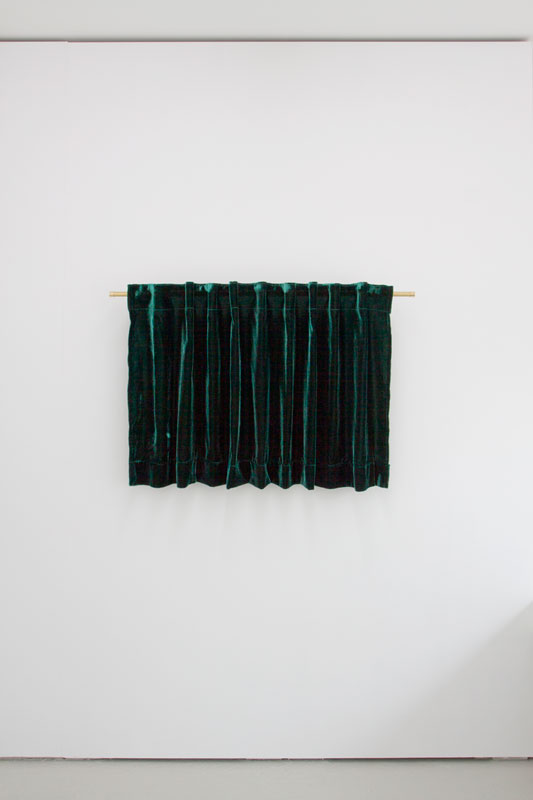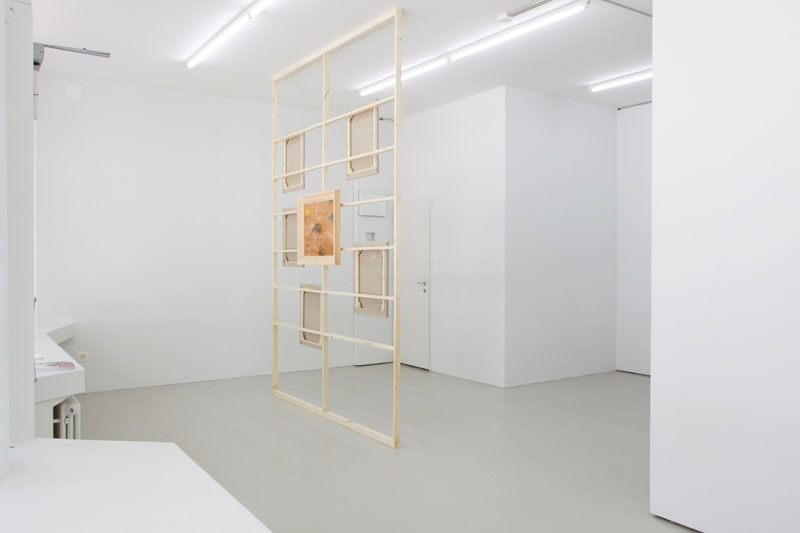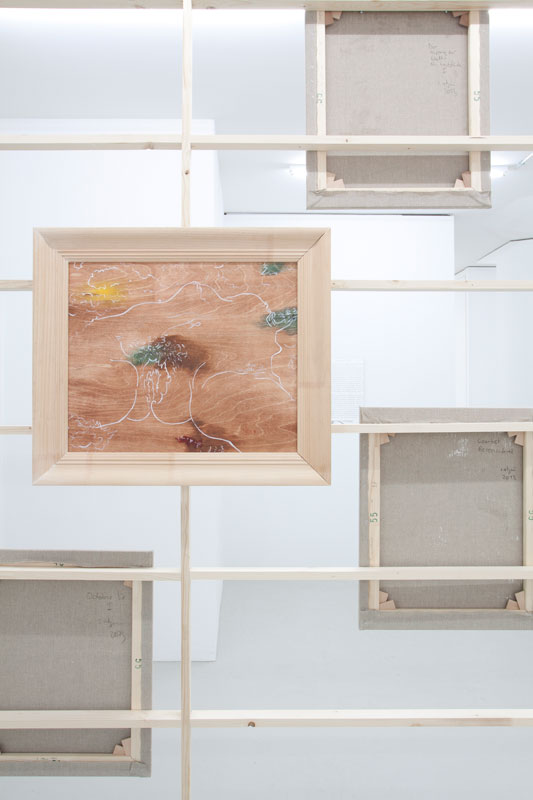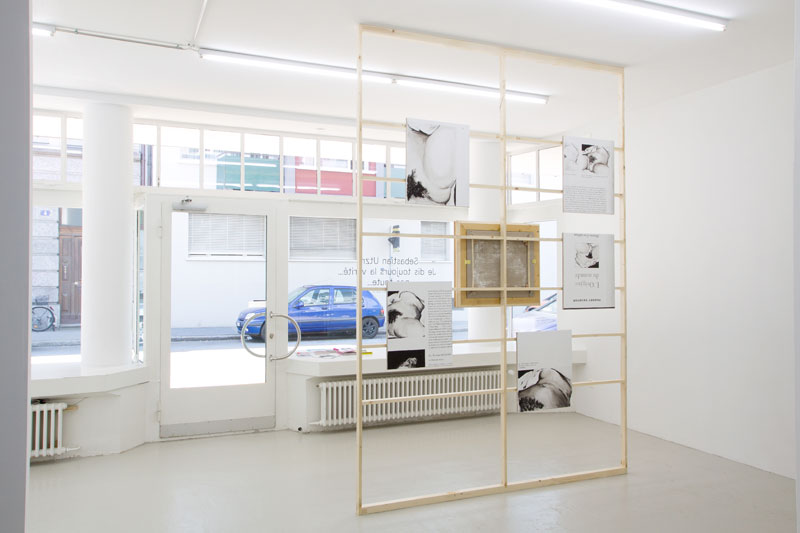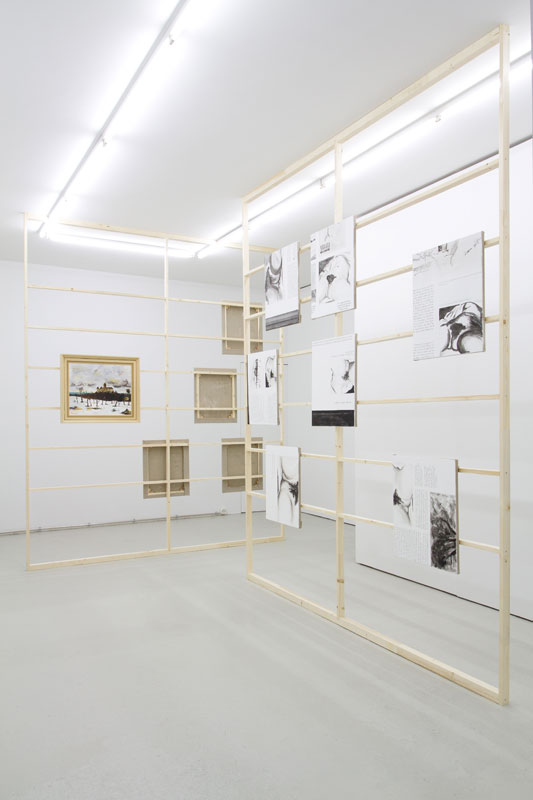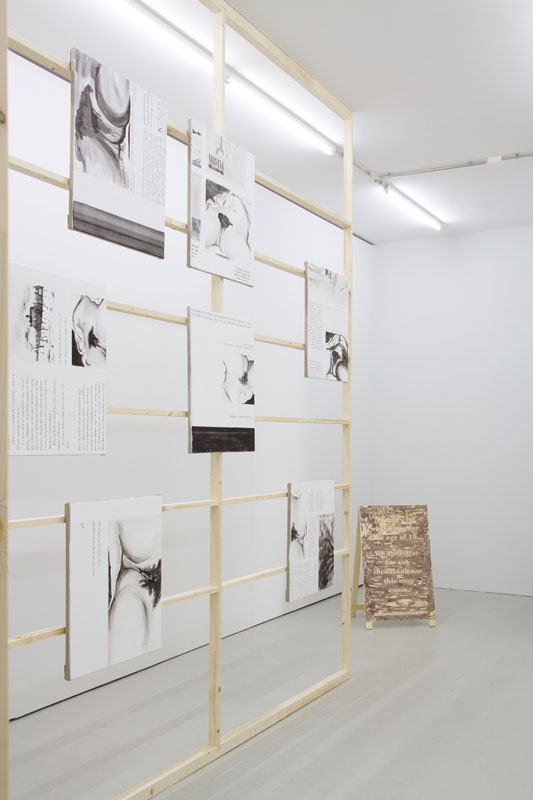Sebastian Utzni
Je dis toujours la vérité…
pas toute…
Event
Sebastian Utzni + San Keller
Mit UV-Edition ins Nachtleben
Mittwoch 10. Juli, Treffpunkt 21 Uhr
Herrmann Germann Contemporary
Sebastian Utzni + San Keller
Mit UV-Edition ins Nachtleben
Mittwoch 10. Juli, Treffpunkt 21 Uhr
Herrmann Germann Contemporary
Sebastian Utzni ist ein Geschichtensammler, Geschichtenerzähler und interdisziplinär arbeitender Künstler. Er gilt als Vertreter der ‹medialen Flanerie› – im unermüdlichen Umherstreifen bietet sich ihm Stoff aus kleinen und grossen Beobachtungen zur Reflexion, Selbstreflexion und Erzählung. Das Allergrösste und das kleine Unbedeutende sind gleich gewichtet. In der Arbeit ‹Werke aus der Sammlung A.H.› 2009 malt und arrangiert Utzni Werke aus der Kunstsammlung Adolf Hitlers im Massstab 1:10 – Pettenkofens Zigeunermädchen zwischen einem lapidaren Blumenstrauss und Böcklins Toteninsel. Das Arbeitsprinzip des Künstlers spiegelt sich beispielhaft in ‹All Bridges from Castletownbere to Dublin› 2010, einem konzeptuellen Bildtagebuch. Utzni dokumentiert seine wandernd erlebten Eindrücke als lange Bänder von schwarz-weissen Holzschnitten. «Ich glaube im Grossen und Ganzen ist es wohl so, dass alles zusammenhängt. Ich suche nicht direkt die Weltformel, versuche eher Sinn aus all den Verbindungen zu machen».
Die Rekonstruktion des Unsichtbaren: Der türkisch-ägyptische Diplomat Khalil-Bey (1831–1879) war Auftraggeber und Besitzer des ‹Ursprungs der Welt› von Jean Désiré Gustave Courbet. Als herausragende Figur des Tout-Paris, besass er eine glänzende Kunstsammlung, die fast ausschliesslich dem weiblichen Körper gewidmet war. Spielschulden zwangen ihn zum Verkauf. In der darauf folgenden Zeit ist das Schicksal sowie das Ab- und Auftauchen des Bildes ungewiss. Bis zu seinem Eingang ins Musée d’Orsay 1995, damals befand sich das Werk im Besitz des Psychoanalytikers Jacques Lacan, war das berühmte Gemälde den Blicken der Öffentlichkeit praktisch verborgen geblieben. Courbets retinale Malerei konnte somit nicht auf das Auge einwirken, sondern diametral über Jahrzehnte nur durch die Vorstellung beziehungsweise durch die Bedeutung im Denken wirken. Die im Zentrum stehenden 46×55 cm bilden den Ausgangspunkt für Utznis Streifzug durch die Geschichte. Der behandelte Mythos dreht sich um Sichtbar- oder besser Unsichtbarkeit, Wiederholung und Reproduktionen von Reproduktionen der Reproduktionen und deren Kontext.
Sebastian Utzni, 1981 in Augsburg D geboren, lebt und arbeitet in Zürich. Herrmann Germann Contemporary zeigt erstmals sein Werk in einer Einzelausstellung. Er studierte Bildende Kunst an der Zürcher Hochschule der Künste. Seit 2008 ist er Gastdozent an der University of Hertfordshire, UK. Auswahl bisheriger Ausstellungen: 2012 Maison André Gouveia, Paris, F; Kunsthaus Grenchen, CH; Yizhao Space, Beijing, CN; 2011 sihlquai55 offspace, Zurich, CH; 2010 Custom House Studios, Westport, IR; Dienstgebäude, Zürich, CH; Museum Bärengasse, Zürich, CH; The Forgotten Bar, Berlin, D; Patriot Hall Gallery, Edinburgh, UK. Residencies: 2011 Cité internationale des Arts, Paris, F; 2010 Custom House Studios, Westport, IRL.
Mit freundlicher Unterstützung von Kyburz & Peck — English Language Projects.
Die Rekonstruktion des Unsichtbaren: Der türkisch-ägyptische Diplomat Khalil-Bey (1831–1879) war Auftraggeber und Besitzer des ‹Ursprungs der Welt› von Jean Désiré Gustave Courbet. Als herausragende Figur des Tout-Paris, besass er eine glänzende Kunstsammlung, die fast ausschliesslich dem weiblichen Körper gewidmet war. Spielschulden zwangen ihn zum Verkauf. In der darauf folgenden Zeit ist das Schicksal sowie das Ab- und Auftauchen des Bildes ungewiss. Bis zu seinem Eingang ins Musée d’Orsay 1995, damals befand sich das Werk im Besitz des Psychoanalytikers Jacques Lacan, war das berühmte Gemälde den Blicken der Öffentlichkeit praktisch verborgen geblieben. Courbets retinale Malerei konnte somit nicht auf das Auge einwirken, sondern diametral über Jahrzehnte nur durch die Vorstellung beziehungsweise durch die Bedeutung im Denken wirken. Die im Zentrum stehenden 46×55 cm bilden den Ausgangspunkt für Utznis Streifzug durch die Geschichte. Der behandelte Mythos dreht sich um Sichtbar- oder besser Unsichtbarkeit, Wiederholung und Reproduktionen von Reproduktionen der Reproduktionen und deren Kontext.
Sebastian Utzni, 1981 in Augsburg D geboren, lebt und arbeitet in Zürich. Herrmann Germann Contemporary zeigt erstmals sein Werk in einer Einzelausstellung. Er studierte Bildende Kunst an der Zürcher Hochschule der Künste. Seit 2008 ist er Gastdozent an der University of Hertfordshire, UK. Auswahl bisheriger Ausstellungen: 2012 Maison André Gouveia, Paris, F; Kunsthaus Grenchen, CH; Yizhao Space, Beijing, CN; 2011 sihlquai55 offspace, Zurich, CH; 2010 Custom House Studios, Westport, IR; Dienstgebäude, Zürich, CH; Museum Bärengasse, Zürich, CH; The Forgotten Bar, Berlin, D; Patriot Hall Gallery, Edinburgh, UK. Residencies: 2011 Cité internationale des Arts, Paris, F; 2010 Custom House Studios, Westport, IRL.
Mit freundlicher Unterstützung von Kyburz & Peck — English Language Projects.
Herrmann Germann Contemporary is delighted to announce the first solo exhibition of German artist Sebastian Utzni. Utzni is a story collector and storyteller, and a visual artist working between and across various disciplines. He is said to represent ‹media flânerie› — for as he tirelessly scours town and country, his observations offer him subjects and materials for contemplation, self-reflection, and narration. Utzni gives equal weight to the most and least prominent. His Werke aus der Sammlung A.H. (2009) (re)painted and (re)arranged works from Adolf Hitler’s art collection on a scale of 1:10 — for instance, placing Pettenkofen’s gypsy girl between a humdrum bunch of flowers and Böcklin’s Isle of the Dead. Utzni’s working principle is well-illustrated by All Bridges from Castletownbere to Dublin (2010), a conceptual visual diary. It documents the many impressions he gathered while wandering across Ireland in black-and-white woodcuts. «On balance, I believe that everything is probably connected. I am not searching directly for a single world formula, but instead I am trying to make sense of all these connections.»
Reconstructing the invisible: Khalil-Bey (1831–1879), a Turkish-Egyptian diplomat, commissioned and owned Jean Désiré Gustave Courbet’s L’Origine du Monde (The Origin of the World). As an outstanding figure of Le Tout Paris, the affluent and fashionable elite of Paris, Khalil-Bey had a marvellous art collection, which was almost entirely devoted to the female body. Gambling debts forced him to sell the collection, after which the fate of Courbet’s painting, its various appearances and disappearances over the passage of time, is unknown. Until it came to be placed in the entrance hall of the Musée d’Orsay in 1995, at a time when it was owned by the psychoanalyst Jacques Lacan, the painting had remained almost completely concealed from public view. Removed from sight, Courbet’s retinal painting could thus not act upon the visual sense for several generations, but instead was left to be conjured up in the imagination and thought for many decades. Measuring 46x55 cm, this work is the starting point for Utzni’s foray into history. The myth treated here centres on the visible or rather the invisible, and the repetition and reproductions of reproductions of reproductions and their specific contexts.
Sebastian Utzni (born 1981 in Augsburg, Germany) lives and works in Zurich. He studied fine arts at Zurich University of the Arts and has been a guest lecturer at the University of Hertfordshire since 2008. Selected exhibitions: 2012 Maison André Gouveia, Paris, F; Kunsthaus Grenchen, CH; Yizhao Space, Beijing, CN; 2011 sihlquai55 offspace, Zurich, CH; 2010 Custom House Studios, Westport, IR; Dienstgebäude, Zürich, CH; Museum Bärengasse, Zürich, CH; The Forgotten Bar, Berlin, D; Patriot Hall Gallery, Edinburgh, UK. Residencies: 2011 Cité internationale des Arts, Paris, F; 2010 Custom House Studios, Westport, IRL.
Kindly supported by Kyburz & Peck — English Language Projects.
Reconstructing the invisible: Khalil-Bey (1831–1879), a Turkish-Egyptian diplomat, commissioned and owned Jean Désiré Gustave Courbet’s L’Origine du Monde (The Origin of the World). As an outstanding figure of Le Tout Paris, the affluent and fashionable elite of Paris, Khalil-Bey had a marvellous art collection, which was almost entirely devoted to the female body. Gambling debts forced him to sell the collection, after which the fate of Courbet’s painting, its various appearances and disappearances over the passage of time, is unknown. Until it came to be placed in the entrance hall of the Musée d’Orsay in 1995, at a time when it was owned by the psychoanalyst Jacques Lacan, the painting had remained almost completely concealed from public view. Removed from sight, Courbet’s retinal painting could thus not act upon the visual sense for several generations, but instead was left to be conjured up in the imagination and thought for many decades. Measuring 46x55 cm, this work is the starting point for Utzni’s foray into history. The myth treated here centres on the visible or rather the invisible, and the repetition and reproductions of reproductions of reproductions and their specific contexts.
Sebastian Utzni (born 1981 in Augsburg, Germany) lives and works in Zurich. He studied fine arts at Zurich University of the Arts and has been a guest lecturer at the University of Hertfordshire since 2008. Selected exhibitions: 2012 Maison André Gouveia, Paris, F; Kunsthaus Grenchen, CH; Yizhao Space, Beijing, CN; 2011 sihlquai55 offspace, Zurich, CH; 2010 Custom House Studios, Westport, IR; Dienstgebäude, Zürich, CH; Museum Bärengasse, Zürich, CH; The Forgotten Bar, Berlin, D; Patriot Hall Gallery, Edinburgh, UK. Residencies: 2011 Cité internationale des Arts, Paris, F; 2010 Custom House Studios, Westport, IRL.
Kindly supported by Kyburz & Peck — English Language Projects.

